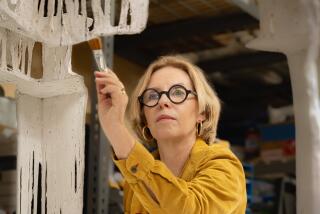Market Growing for Preservation Goods : Restoration: The movement, which fiercely cherishes and embraces older objects, monuments and symbols of culture, is picking up speed.
BOSTON â They meandered from one booth to another, picking up glossy brochures, admiring sample reprints of Victorian wallpaper, and discussing the latest techniques in stained-glass restoration.
They are preservationists, and hundreds converged on Boston in early December to attend Restoration â93--a trade show featuring workshops, seminars and the largest number of displays relating to preservation under one roof. For three days architects, collectors, interior designers, trades people, antique-house owners and other preservation junkies absorbed the latest issues and techniques in areas ranging from bookbinding to sculpture, historic carpets to home renovation.
These aficionados and others like them here and in Europe are creating a widening marketplace for services and goods geared to preservation. They are part of a movement that fiercely cherishes and embraces older objects, monuments and symbols of culture. Itâs a sharp contrast from views espoused up through the mid-1970s. Take the field of historic architecture, for instance.
âJust 25 years ago the prevailing notion was if it ainât Colonial it ainât worth saving. Anything built after 1830 was considered ripe for the wreckerâs ball,â said Clem Labine, editor and publisher of Traditional Building magazine.
She added: âThe prevailing philosophy was summed up in a headline which I will never forget in House Beautiful magazine: âGloomy old Victorian transformed into cheerful contemporary home.â Today these same magazines are publishing stories on how these cheerfully muddled Victorians are being restored to their original Victorian elegance.â
During the nationâs bicentennial, in 1976, people began looking at preservation and restoration in a new light, said Thomas Fisher, editor of Building Renovation magazine. But the real estate market of the 1980s ushered in a period of frenzied new construction, which affected the budding restoration industry. Now âas new construction is depressed, this industry is going to boom,â Fisher predicted.
âThis whole conference exemplifies the increasing awareness that the preservation movement is gaining speed,â said Heidi Gruenke Emery, vice president of Conrad Schmitt Studios, artisans in Berlin, Wis., who have restored buildings ranging from St. Louisâ Union Station to Bostonâs Wang Center for the Performing Arts.
As the movement grows, it must grapple with a number of issues. Contrasted with Europe, where restoring treasures of the past is a way of life, the United States has fewer skilled people who can hand down traditions and practices.
Moreover, some advocates say that because few architects and others are trained in preservation, many restoration jobs are inadequate. And environmentalists have raised concerns over how new technologies, materials and increased preservation efforts will affect the environment.
âEven though there is this unstoppable trend for historical symbolism in our built environment, there will be a continual tension between restoration . . . and the green movement,â Labine said. âThe paradigm used to be historic authenticity at any price. The new paradigm will be historic authenticity at a reasonable environmental cost. Questions such as: Where is all that stripped lead paint going to wind up anyway? Is it worth the environmental cost to replace that roof with real slate or with a slate look-alike?â . . . will be asked more and more in the next few years.â
Still, many preservationists see restoring old houses instead of tearing them down for new construction as a boon to the environment. âWhen you pull a building down the debris has to go somewhere . . . normally to a landfill,â Labine said.
Preservation work requires less material and more labor, increasing jobs while decreasing energy costs, Fisher said.
Is the move toward preservation a fad or a fixture?
âLook at the Colonial revival,â Labine said. âIt started in 1890, and it hasnât let up since.
âFor me, the perfect project for the 20th Century would be a neoclassical construction for all its social, historical and cultural connections with the golden age of Greece. But the magnificent ionic column on my dream construction would be made not from marble but from the resin of recycled plastic milk jugs.â





